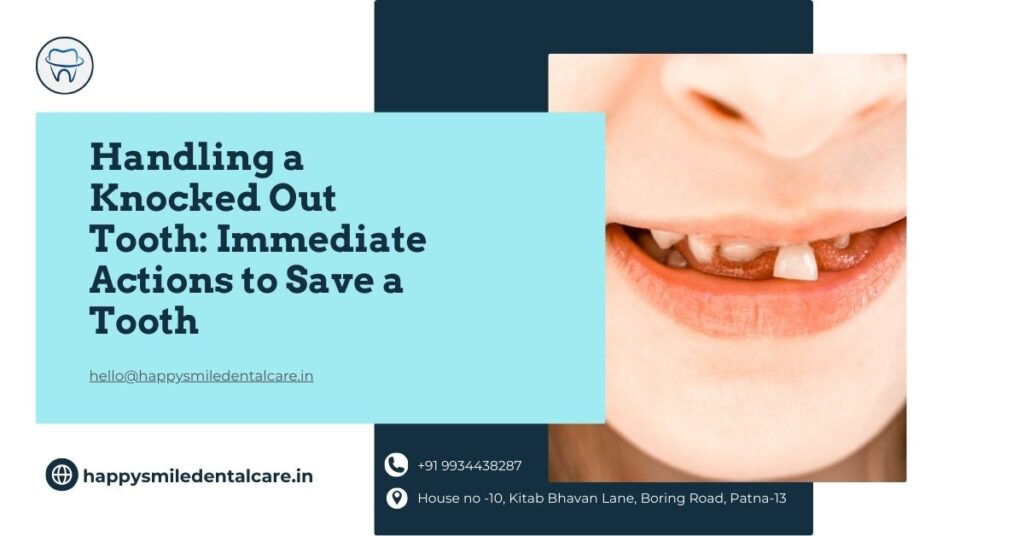A knocked-out tooth, or tooth avulsion, can happen to anyone—whether it’s during a child’s rough-and-tumble play, an accidental fall, or a sports mishap. It’s a dental emergency that requires immediate attention, but the way you handle it in the first few minutes can make all the difference. With the right steps, you might be able to save the tooth and restore your smile.
This guide will walk you through the immediate actions to take if you or someone you know experiences a knocked-out tooth. Plus, as your trusted resource, Happy Smile Dental Care is here to provide expert care for emergencies and follow-ups.
1. Understanding Knocked-Out Teeth
1.1 What Happens When a Tooth is Knocked Out?
Teeth are secured in the jawbone by roots, a network of ligaments, and surrounding gum tissue. When a tooth is knocked out, this connection is severed. Permanent teeth have a better chance of being reattached if handled properly, but this is a race against time. Baby teeth, on the other hand, are generally not re-implanted.
When a tooth is dislodged, the blood vessels and nerves linked to it are also disconnected. While the tooth can no longer fully regain its natural blood and nerve supply, swift action can increase the odds of success in preserving its functionality and appearance.
1.2 Types of Teeth Most Commonly Knocked Out
- Primary Teeth (Baby Teeth): Common in children due to their active nature. However, these are typically not re-implanted. The focus is on preventing damage to the developing permanent tooth underneath.
- Permanent Teeth (Adult Teeth): These can often be saved if quick action is taken.
2. Immediate Actions to Take After a Tooth is Knocked Out
2.1 Stay Calm and Assess the Situation
Panicking can prevent you from taking the right steps. Calmly assess whether the tooth belongs to a child or an adult (permanent or primary tooth). If it’s a permanent tooth, handle it gently and focus on preservation.
2.2 Locate the Tooth
Find the tooth as soon as possible. Check in and around the site of injury and ensure it has not been damaged further. Handle it carefully to avoid causing unnecessary harm.
2.3 Handling the Tooth Properly
When you retrieve the tooth, hold it by the crown (the top, white part visible when in the mouth). Avoid touching the root (the part that anchors the tooth into the gum), as it contains delicate fibers crucial for reattachment.
3. Steps for Saving a Knocked Out Tooth
3.1 Rinse and Clean the Tooth (If Necessary)
If the tooth is dirty, gently rinse it with sterile saline solution or clean water. Avoid scrubbing or using soap, as this can damage the root. Pat it dry gently on a clean cloth.
3.2 Repositioning the Tooth (If Possible)
If the tooth is a permanent one, consider reinserting it into the socket:
- Gently place the tooth into the socket, aligning it in the correct direction.
- Hold the tooth in place by biting down lightly on a clean cloth or tissue.
If reinsertion isn’t possible:
- Proceed to step 3.3 for safe storage.
3.3 Storing the Tooth Safely
The tooth must stay moist to preserve the root. If reinsertion isn’t possible:
- Place the tooth in a container with milk.
- Alternatively, use a saline solution or specialized tooth preservation kit if available.
- Do not store the tooth in tap water, as it may harm the root cells.
4. When to Seek Professional Help
4.1 Importance of Timely Dental Care
Time is of the essence—a knocked-out permanent tooth has the best chance of survival if treated within 30 minutes to 1 hour. Contact a dental professional immediately to increase the odds of successful reattachment.
4.2 What to Expect at the Dental Office
At Happy Smile Dental Care, we specialize in addressing dental emergencies. Here’s how we can help:
- Tooth Re-implantation: If the tooth has been preserved well and timely action is taken, our team will attempt to reattach the tooth to its socket.
- Stabilizing the Tooth: A splint may be used to hold the tooth in place while it heals.
- Follow-Up Care: We’ll monitor healing and provide treatments, if necessary, to ensure long-term success.
5. Preventive Measures and Tips for Future Safety
5.1 Protecting Teeth During Sports and Activities
Invest in a custom-fitted mouthguard, especially for children and athletes. A mouthguard provides a cushioning layer that protects teeth during high-impact activities.
5.2 Teaching Kids About Dental Safety
Encourage children to play safely and educate them on the importance of protecting their teeth during sports and energetic activities.
Why Choose Happy Smile Dental Care?
While other sources like AAE and NHS Inform cover tooth avulsion, Happy Smile Dental Care provides specialized local services with a personal touch. Our team is here to answer your questions and deliver expert care that’s tailored to your needs.
With years of experience and state-of-the-art tools, we’re dedicated to restoring your smile and safeguarding your dental health.
Act Now to Protect Your Smile
Dealing with a knocked-out tooth can feel overwhelming—but by staying calm and taking the right steps, you can preserve the tooth and prevent long-term damage.
Remember, time matters in dental emergencies. For immediate care, reliable expertise, and follow-up services, contact Happy Smile Dental Care today. Schedule an appointment with our team to discuss preventative tips or handle any dental emergencies.
Conclusion
Your smile is one of your most valuable assets, and at Happy Smile Dental Care, we are committed to helping you maintain it. By being prepared and knowing how to handle dental emergencies like a knocked-out tooth, you can save your smile and protect your oral health. Don’t wait for an emergency to strike—take proactive steps today and trust our experienced team to be by your side every step of the way. Together, we’ll keep your smile happy and healthy for years to come.

